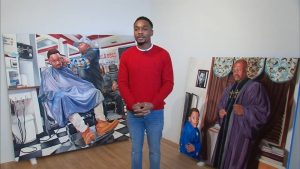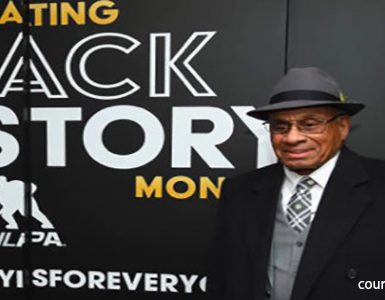Black art in America originated in slave communities predating the civil war. Black art tells the stories of the struggles, victories, and emotions of a group of people bound by a common experience and traditions. It includes various expressions from paintings to photography.
Through the installation of 21st-century art, we have questioned American history and the psychology of racism such that their display can no longer be viewed as they were in the past. Through the works of Artis Lane, Jean-Michel Basquiat, Kara Walker and others, Black artists continue to speak for the history, culture, and heritage of Black people.
And so, the story continues. As I researched information on my featured artist, I came across an “open letter” penned by Isis Dallis titled “We Need to Talk About How Media and Creatives Portray Black people.” Dallis wrote “as image-makers, platform builders, conversation managers, and storytellers, we contribute to the images, messages, and perceptions that circulate within our society and culture. These images and messages have tremendous power. They have the power to influence the thoughts, feelings, and behaviors of our collective society today and for generations to come.”
Our perceptions of how we view others deepens by the images we see, whether positive or negative, and have the capacity to make people see and recognize the humanity in others, or the power to diminish and dehumanize others. What was most compelling to me in what she wrote was that the words and images we create and choose to circulate create powerful mental associations that define how we perceive each other and the world around us. They have the power to make people feel fearful of others, or the power to make them feel safe. Specifically, what we see in the media and throughout society draws a picture enabled by myths suggesting Black people are less deserving, lack ambition, and are wholly responsible for conditions that are, in fact, outside of their control.
These associations portray inaccurate narratives for Black people and are real and significant. Here is where I highlight an artist who is changing the narrative of Black Americans, the way Black Americans are portrayed, and moving the conversation forward with art.
Tackling Race in America: Artist Spotlight
Tyler Ballon is a 25-year-old Black American art school graduate of the prestigious Maryland Institute College of Art. Ballon grew up in the New Jersey Pentecostal church and is the son of pastors. He began drawing as a hobby when he was four years old, but as he grew older art became a form of meditation. His grandmother saw his potential and he was inspired by her to pursue art.
His subject is the Black American home, his family, and the circle of people within the church and the local community in Greenville, Jersey City, where he spent his childhood and still lives and works.
Ballon’s oil paintings incorporate religious imagery and symbolism to create narratives around his experience as a Black man and the shared experiences of members of his community. While story means so much in every culture and ethnicity, Black people, regardless of how they got here, are planted in story and shared lived experience.
While in college, Ballon said he experienced first-hand the protests after the death of Freddie Gray, after which he began to focus on themes of racial injustice. He has dedicated himself to art as a way to speak for people of color. His artwork tells the story of fortitude in life, breaking the stereotypes that have been placed on Black Americans.
Ballon’s imagery goes against the stereotype of people of color in the mass media. His work celebrates the love of family, partners, and one another that emanates from the Black Christian church. One of his primary subjects is the professions that members of his community were able to pursue within the white power structure, such as pastors, barbers, and hairstylists. He focuses on the careers that involve intellectual achievement and technical skill rather than the physical prowess of athletes. He strives to separate his celebration of Black community from the stereotype of slaves’ bodies. His work emphasizes love and spirituality as the path to advancement.
Ballon’s paintings are infused with his Christian faith. He views the Black church as a place of comfort and strength. It is a structure to pass down information, commemorating the accomplishments of the past and inspiring the present generation to change the future.
A Synopsis of a Black Man’s Art
Drawing on his childhood experience at a Catholic school, he employs Classical painting techniques with distinctly contemporary imagery, conveying compelling images riddled with empathy. Strengthen the Brethren (2020), for instance, depicts one man standing firmly with arms outstretched to help another figure—perhaps a friend or brother—off the ground in an act of support.
Apple of my Eye (2021) depicts the special relationship between a mother—the artist’s sister—and her daughter as she grooms her hair. The mother is teaching her daughter how to love herself, understanding her value on earth.
Little Girls (2021) portrays four of the artist’s nieces, but commemorates the tragedy in the church in Birmingham, Alabama, in 1963, in which four young girls were murdered. The work memorializes the lives that were cut short. It brings forth both the humanity of the girls and the potential for renewal.
Barber Shop (2021) shows one of the central institutions in the Black community. Real Deal is the actual barber shop where the artist has had his hair cut since the age of four. The figure in the barber chair is Ballon himself. The artist explains that the barber shop is where he learned a lot about being a man. It was his first experience with men outside his household. For him, the barber was not just cutting his hair, he was cutting away the possible mistakes he could have made that would have destroyed his future. The artist stated that his visits to the Real Deal barbershop taught him how to deal with actual real-life situations.
Out with the Old…In with the New Narrative
Drawing on his passion, Ballon dispels four hundred plus years of false representation of Black Americans through his artwork. He says his paintings are meant to counter the negative narrative in which he feels the Black American community is often trapped. I am in awe of this young man and what he is representing and teaching as an artist! He uses the platform of artistry to honor what the Black experience feels like, right here, right now. “We don’t always have to be in conflict or struggle to be seen as significant in American society,” he said.
For me, what’s so powerful for Black Americans is being able to tell our own story. I am reminded of all the strong narratives that have come out of the Black American experience. Storytelling is our roots and wings.
Tyler Ballon is indeed moving the conversation forward by changing the narrative of Black Americans through art.


















Add comment